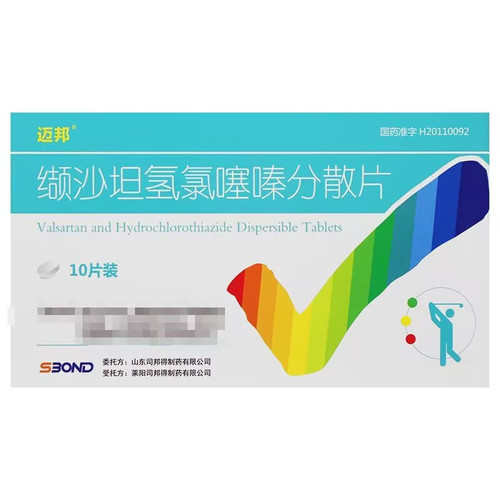Product Overview
[Drug Name]
Generic Name: Valsartan and Hydrochlorothiazide Dispersible Tablets
Trade Name: Renhe Valsartan and Hydrochlorothiazide Dispersible Tablets (21 tablets)
Pinyin Code: RenHe XieShaTanQingLvSaiQinFenSanPian 21 Tablets
[Main Ingredients]
This product is a combination preparation. Each tablet contains 80mg of valsartan and 12.5mg of hydrochlorothiazide.
[Appearance]
This product is a white or off-white tablet.
[Indications/Main Functions]
It is used to treat mild to moderate essential hypertension where blood pressure cannot be adequately controlled with a single medication. This product is not suitable for the initial treatment of hypertension.
[Specifications]
21 tablets
[Dosage and Administration]
Each tablet contains 80mg of valsartan and 12.5mg of hydrochlorothiazide. It is indicated for use when blood pressure cannot be adequately controlled with valsartan alone. If hydrochlorothiazide 25 mg once daily fails to satisfactorily control blood pressure or hypokalemia occurs, this product (combined with valsartan 80 mg/hydrochlorothiazide 12.5 mg) can be used as an alternative, one tablet once daily. Maximum antihypertensive effect is achieved within 2-4 weeks of treatment. No dose adjustment is required for patients with mild to moderate renal failure (creatinine clearance > 30 ml/min) or mild to moderate hepatic failure (non-biliary, non-cholestatic).
[Adverse Reactions]
See package insert for details.
[Contraindications]
Hypersensitivity to valsartan, hydrochlorothiazide, other sulfonamides, or any of the ingredients in this product. Pregnancy (see Pregnancy and Lactation). Severe hepatic impairment, biliary cirrhosis, or cholestasis. Severe renal failure (creatinine clearance < 30 ml/min) or anuria. Refractory hypokalemia, hyponatremia, or hypercalcemia, and symptomatic hyperuricemia.
[Precautions]
Serum electrolyte changes require caution when using this medication with potassium-sparing diuretics, potassium supplements, potassium-containing salt substitutes, or other medications that increase potassium levels (such as heparin). Hypokalemia has been reported with thiazide diuretics, so serum potassium levels should be monitored regularly. Thiazide diuretics, including hydrochlorothiazide, have been associated with hyponatremia and hypochloremic alkalosis. Thiazides, including hydrochlorothiazide, can cause hypomagnesemia by increasing renal magnesium excretion. Sodium and/or volume depletion: In rare cases, symptomatic hypotension may occur when initiating treatment with this medication in patients with severe sodium and/or volume depletion (e.g., those taking high-dose diuretics). These hyponatremia and/or volume depletion should be corrected before initiating this medication. If hypotension occurs, the patient should be placed in the supine position and, if necessary, given normal saline. Treatment can be resumed after blood pressure stabilizes. Renal artery stenosis: There is no experience with this medication in patients with unilateral or bilateral renal artery stenosis or solitary kidney stenosis. Renal Impairment: No dose adjustment is required for patients with renal impairment and a creatinine clearance ≥30 ml/min. Hepatic Impairment: No dose adjustment is required for patients with mild to moderate hepatic impairment that is not cholestatic, but this product should be used with caution. Liver disease does not significantly affect the pharmacokinetics of hydrochlorothiazide. Systemic lupus erythematosus: Thiazide diuretics, including hydrochlorothiazide, have been reported to induce or exacerbate systemic lupus erythematosus. Other Metabolic Disorders: Thiazide diuretics, including hydrochlorothiazide, can impair glucose tolerance and increase serum cholesterol, triglyceride, and uric acid levels. Effects on the Ability to Drive and Operate Machinery: As with other antihypertensive drugs, patients taking this medication should exercise caution when driving and operating machinery. Effects on Athletes: This product contains hydrochlorothiazide. Thiazide diuretics can affect the metabolism and excretion of stimulants, potentially reducing the sensitivity of urine tests for stimulants. Therefore, athletes should use this product with caution.







